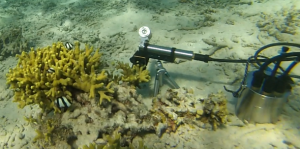With the International Coral Reef Symposium meeting in Honolulu later this year, we thought it is a good time to illustrate how Aquation Shutter Fluorometers can be used to measure coral health.
As you can see in the images, the Shutter Fluorometer is positioned adjacent to, or over, a coral. Most of the time the Shutter is open, with the area of interest exposed to freely-flowing water and natural sunlight. When a measurement is due, the Shutter closes over the sample, excluding natural sunlight, and performs a saturating pulse measurement. Then, the Shutter can either open again and wait till the next measurement, or it can remain closed and the sample can be variously treated to actinic light (such as a rapid light curve), or left to dark acclimate for a predetermined interval. Measurements of Fo’ are possible by closing the Shutter, taking a measurement and leaving the Shutter closed for 10 seconds with the Far Red Light on, followed by another saturating pulse measurement. Fo’ is used in a range of quenching calculations.
By programming the Submersible Datalogger, you can select the interval between measurements, and the type of actinic treatments to be applied.
And the best part is you don’t have to be underwater to dark-acclimate the sample, as the Shutter Fluorometer does this for you. Particularly useful for frequent measurements in deep water, or those early morning measurements when coffee calls rather than a wet wetsuit…

Shutter Fluorometer measuring photosynthesis of a coral. Note PAR sensor makes simultaneous light measurements, enabling calculation of Electron Transport rate (ETR) in situ.

Shutter Fluorometer and hard coral. Here the Shutter is open, allowing water and light to naturally influence the sample. The Submersible Datalogger is to the right of the coral in the image.




